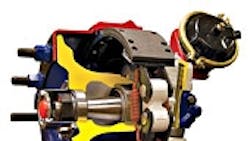Guidelines show how to get the most out of wheel ends
The safety and performance of wheel ends are critically important in the trucking industry since they literally keep things rolling.
These dynamics make a strong case for purchasing individual components from a single supplier that can combine high-performance products and warrant their performance. Conversely, they can be purchased separately from different suppliers, but usually with shorter-term warranties for the individual components. Here are a few tips for getting the most out of your wheel end systems:
- Bearing adjustment
This is one of the most important factors in wheel end performance. TMC RP 618 recommends setting axial bearing end-play at 0.001/0.005 inches for optimal bearing life. Slight end-play provides a means of measuring the setting, while providing good load distribution over the bearing rollers. Optimal bearing life can be accomplished using a slight pre-load as defined by SAE J2535. However, users must understand the risks associated with pre-load and monitor their assembly procedures accordingly. Excessive bearing pre-load can result in premature, even catastrophic failure. Excessive end-play can also adversely affect both the bearings and seal life. Several methods are available to provide appropriate bearing settings, the simplest and most reliable of which are single-nut and spacer systems.
- Cleanliness
Wheel end components, especially the lubricant, should be kept free of moisture, dirt, metal particles, and other debris that can damage them. High-performance hub caps and seals can help maintain the integrity of the system for long life by keeping moisture and contaminants out of the wheel end. Appropriate handling procedures should also be followed to exclude contaminants.
- Venting
Wheel end systems heat and cool in operation, creating internal pressure fluctuations that need to be managed. Typical venting methods use either the hubcap or axle. This release of pressure is critical to performance of oil seals as increased pressure can add loading to the sealing element (an exception are grease seals with the ability to vent). Long-life systems that relieve internal pressure and vacuum also prevent moisture and contaminants from entering the system.
- Lubricants
The best lubricant for wheel bearings is oil, which runs cooler than grease and flushes contaminants from the bearings more effectively. Oil systems can be monitored through a hubcap window and adjusted accordingly. Grease systems (hard pack and semi-fluid) are also frequently utilized, but require periodic inspection by removing the hubcap to check the amount and quality of grease present. Grease should also be checked to ensure it is properly mixed (not separated) prior to being used in the wheel end.
- Quality
Wheel end components are available in different grades and price levels. Premium, high-quality components will deliver superior performance and longer service life than less expensive, lower-quality parts.
- Installation
Just as important as the components comprising wheel end systems is installing them properly. Training in installation best practices is critical to assuring their safety and long-term performance.
As noted, there are significant benefits to dealing with a single supplier that can provide all the components for a total wheel end system that meets the above criteria. This approach not only promises better performance, but also the security of extended warranty coverage. Note: Always check with your wheel end component supplier for proper installation, use and performance of their products.
